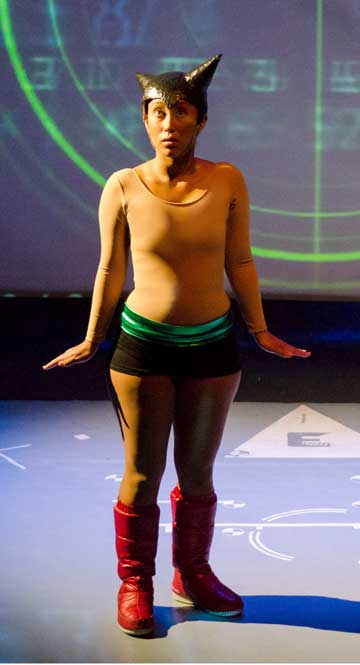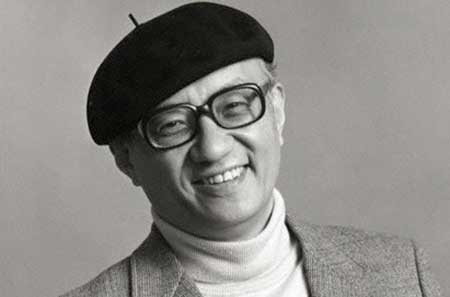Play (2012)
Written and directed by Natsu Onoda Power
Company One Theatre
Boston Center for the Arts
South End, Boston, MA
July 18 – August 16, 2014
With Phil Berman, Jessica Chance, Gianella Flores, Amanda Ruggiero, Jeff Song, Robertt St. Laurence, Kaitee Tredway, Clark Young

in “Astro Boy & The God of Comics”
Photo: © 2014 Liza Voll
Courtesy of Company One Theatre
This reverse chronological story begins with a cartoon wonderfully drawn before us on a screen size pad. Astro Boy (Gianella Flores) then shows up and we begin a story about radiation, poisoning of the earth and a mission our hero takes to address the source of the problem on the sun. Before long, however, the story turns to the innovative author of the comic that features Astro Boy, Osamu Tezuka, and, scene by scene we trace back through the author’s life until we hit his origins in the late 1920s in Japan.
What begins as a whimsical sci-fi tale based on a cartoon character feels, at the outset, like a fun, but insubstantial, piece of theater, energetic in its action, but not terribly devoted to anything beyond its wonderfully entertaining stage effects, strongly focused on a front screen which doubles as a template for video projections and gets drawn upon by the cast.

Photo: © 2014 Liza Voll
Courtesy of Company One Theatre
And what wonderful drawings they do! The first of these is generated in quite an amazing way, with a passel of cast members coming onstage each with a pen and encricling a piece of a projected abstract image. It looks like a bunch of ovals until magically they get connected and filled in, embellished, and, all of a sudden, there is a cartoon, on paper, of Astro Boy and his sidekicks.
The ingenuity with which the projections generate the initial components of the final image, and the speed and dexterity and general competence with which the cast connects and fills out that image, are really something.
This wondrous interplay between video, live character and drawn image takes place over and over again as the play progresses with cast members, at intervals, tearing off the humongous pieces of paper on the screen/pad, only to reveal an underlying page which is then drawn all over again.
At first the effect of this is merely ingenious, though fantastically so. However, as the play progresses through the reverse stages of time, we gradually begin to meet Tezuka, to understand a bit about him, and to get a chance to get an evolving sense of his own character and inspiration.
This turn from the comic book introduction to the heart and soul of its creator is what sets this play apart as a moving character study rather than just and ingeniously engineered entertainment.

Tezuka’s defiance of his father’s wishes that he enter a more serious profession, his devotion to drawing, even his way of dresssing idiosyncratically with an everpresent beret, come into the story. And, as well, we sense the horrors of World War II including the dropping of the bombs at Hiroshima and Nagasaki with a riveting collective drawing of a mushroom cloud with horrific
At first, the notion of a reverse chronology seems an unnecessary ploy, but soon its significance reveals itself. For we see, at the outset, only the superficial jubilation of the young and exuberant Astro Boy but do not get any of the sense of what or who underlies it. As the play progresses, the play begins to reveal the life and mind of the artist.
So this play becomes an interesting semiotic journey backwards from the emblem of the cartoon character to the character who invents it. It is not surprising then to find out that the author of the play and the director of this production, Natsu Onoda Power, has a doctorate in performance studies and has even written a play based on the philosophical text Madness and Civilization by the great French postmodernist Michel Foucault.
This play, indeed, suggests that there is more than meets the eye behind comics and their characters and its technique of starting with those characters and working backwards is an ingenious one with surprisingly moving results.
– BADMan
Leave a Reply